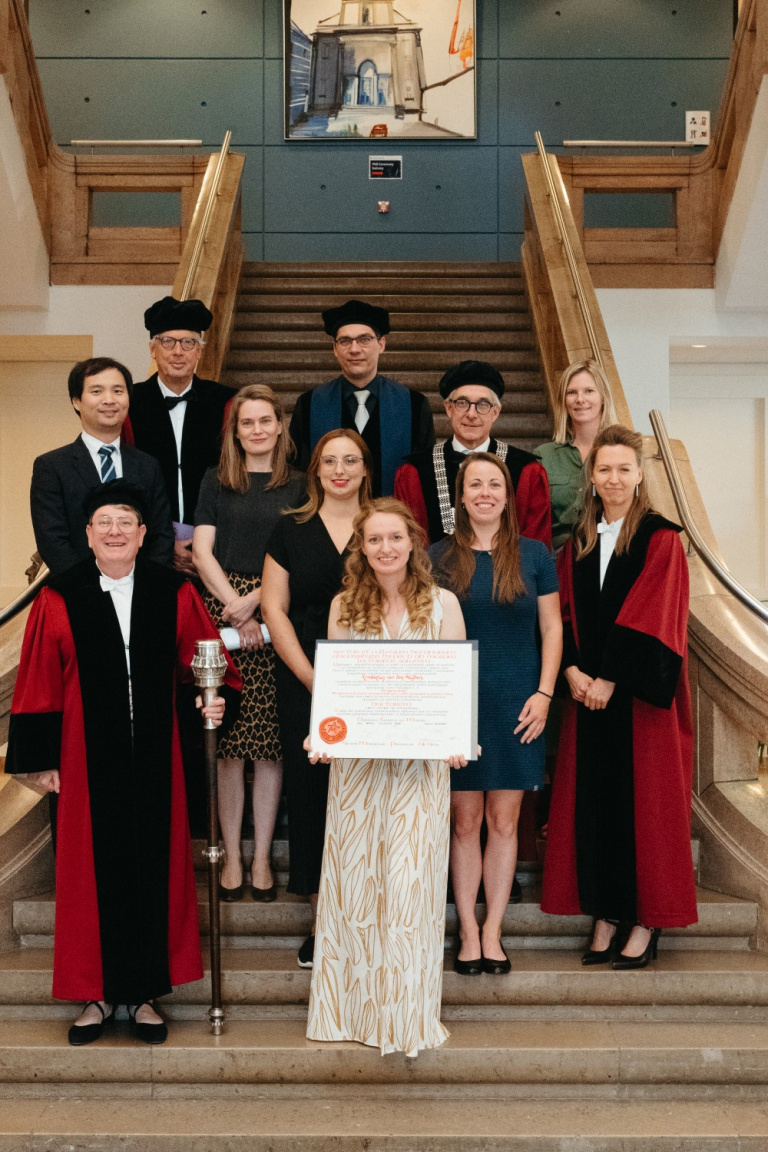 1950-2025 Roots and Wings
Discover our 75th anniversary
1950-2025 Roots and Wings
Discover our 75th anniversary

On the bright side
Lecturer Kimberley van der Heijden defended her PhD dissertation and demonstrates how light in restaurants can have an effect on taste intensity of food.
"We human beings are a selfish bunch, so it’s all the more surprising to see how easily we can be manipulated to behave in ways that run counter to our own self-interest" - Dan Ariely, Predictably Irrational
Kimberley van der Heijden successfully defended her dissertation ‘The more, the better? How variations in the amount of environmental stimuli impact consumer behavior and decision making’ on the 28th of June. During the ceremony, which took place at Maastricht University, she presented the results of her research in front of her supervisors, the degree committee, friends, family, colleagues from Hotel Management School Maastricht and other guests.
Kimberley did her PhD in Consumer Behavior at Maastricht University and has been working at the Hotel Management School Maastricht as lecturer Consumer Psychology since February 2022.

Research on taste intensity
In one of the studies which was part of her research, Kimberley and her co-researchers investigated the influence of ambient light on taste intensity. Restaurants often use light to create a certain atmosphere; think about a candle-light dinner to set a romantic mood for example. But if you wish for your guests to experience a more intense flavor while tasting your dish, it would be better to turn up the brightness! ‘There has been a lot of research on the effects of light and how it influences people’s decisions. If you go out for dinner, one of the main reasons is to experience a tasty dish. We thought it would be interesting to research the effect of light in this context. We also chose to conduct the experiment in a real restaurant instead of a lab.’
Experiment at the Teaching Hotel
That real restaurant was L’Étoile, the restaurant of the Teaching Hotel.
Guests in L’Étoile were asked to try a new dish and provide feedback about the flavor. However, they did not know they were participating in an experiment. During the experiment the light in the restaurant was manipulated and on different days it was either a bright ambient light or dim ambient light. After finishing the dish, the guests were asked to fill in a small survey including questions about taste intensity.
The results? ‘We discovered that guests who enjoyed their meal in a brightly lit restaurant experienced a more intense taste of the dish. This does not per se mean more tastier, but the flavor of the dish was more intense for them compared to the guests who had their dish in dimly lit restaurant.’ To rule out additional factors that could possible influence the taste intensity they conducted two follow-up experiments. ‘It could be that a dish is more visible under the brighter light. However, if people were given two photos of a dish and were asked about the expectation of the taste intensity, people judged that expectation equally. We also looked at whether the background music in the restaurant had an influence, but this turned out not to be the case in our study.’
Valuable results for the hospitality sector
The research shows how you can influence people, consumers, in decision making – without them being aware of it. An abundance of stimuli – in this case light - can affect the choices consumers make and how they experience a night out in a restaurant.
For restaurants and other hospitality establishments these results can be very valuable. ‘Lighting is often overlooked, while our research shows it can be of great value. It is also an aspect that is easy to change and doesn’t require a lot of expenditure.’ The research does not claim that lighting is the most important aspect for a restaurant – ambiance and other factors play a role as well. However, it does show how you can influence customers and have them enjoy a more intense taste of your dishes!
Kimberley's full research On the bright side: The influence of brightness on overall taste intensity perception is published in Food Quality & Preference
Highlights

Terugblik op 2025: hoogtepunten van Hotel Management School Maastricht
2025 was a year full of change and memorable moments for Hotel Management School Maastricht.


Future Game Changers | Maia Povia
In this blog, Maia Povia, a Future Game Changer, shares her experiences, ambitions and vision for the future of hospitality.


Future Game Changers | Mickey Venendaal
In this blog, Mickey Venendaal, a Future Game Changer, shares his experiences and vision for the future of hospitality.

